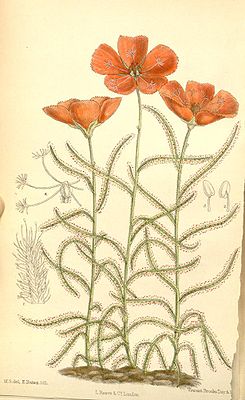Drosera cistiflora
| Drosera cistiflora | ||||||||||||
|---|---|---|---|---|---|---|---|---|---|---|---|---|

Drosera cistiflora , illustration. |
||||||||||||
| Systematics | ||||||||||||
|
||||||||||||
| Scientific name | ||||||||||||
| Drosera cistiflora | ||||||||||||
| L. |
Drosera cistiflora is a carnivorous plant belonging to the genus sundew ( Drosera ). It is native to South Africa and wasfirst describedby Carl von Linné in 1760. In addition to Drosera capensis , it was the first described sundew species of the Capensis .
description
Drosera cistiflora are herbaceous plants with a stature height of 10 to 40 centimeters and one or two long, swollen roots , densely covered with root hairs. The native rosette is temporarily missing when the plants form the long, unbranched stems densely covered with glandular hairs.
The leaves are without stipules , mostly sessile and dimorphic. The leaves of the rosette close to the ground are narrow, inverted ovoid, 1.2 to 2, rarely up to 3 centimeters long, with a wedge-shaped point at the base. The leaves on the stem are arranged alternately, linear to linear-lanceolate, 2 to 4 centimeters long and pointed at the end.
The inflorescence is terminal, one to multi-flowered, the thin flower stalks are up to 3 centimeters long. The sepals are fused, the individual lobes are up to 9 millimeters long and pointed. The petals are broadly inverted egg-shaped, white, pink, yellow, dark red or purple, dark green at the base, notched at the tip and have a length of up to 2 centimeters.
The short stamens are dark green, the connective rhombic. The stylus are forked from the base, long, curved upwards, the scars divided into a fan-shaped manner. The capsule fruit is twisted, the seeds ovate-elliptical, brown and tiny, with a honeycomb surface.
The number of chromosomes is 2n = 40 or 60.
distribution
The species is native to South Africa and widespread from Namaqualand to Port Elizabeth , where it grows in the fynbos on slopes and plateaus in sandy locations or as a pioneer plant on disturbed locations.
literature
- Anna Amelia Obermeyer: Droseraceae. In: The Flora of Southern Africa. Volume 13: Cruciferae, Capparaceae, Resedaceae, Moringaceae, Droseraceae, Roridulaceae, Podosfemaceae, Hydrostachyaceae. Botanical Research Institute - Department of Agricultural Technical Services - Republic of South Africa, Pretoria 1970, pp. 187-201.
Individual evidence
- ↑ Drosera cistiflora at Tropicos.org. In: IPCN Chromosome Reports . Missouri Botanical Garden, St. Louis